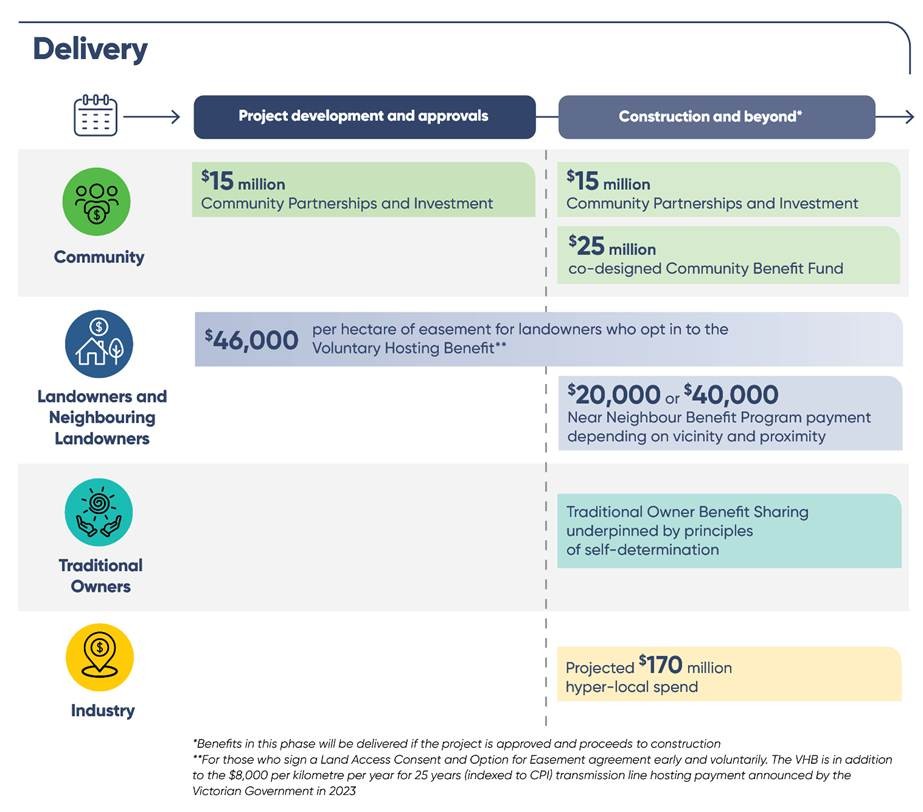The Western Renewables Link (WRL) project, delivered by AusNet, has committed $55 million to deliver lasting benefits to regional communities along the proposed project route, recognising their essential role in enabling Victoria’s transition to renewable energy.
This commitment was outlined in materials submitted as part of the opening of the Environment Effects Statement (EES) panel hearing process and shared with landowners along the proposed route.
Of this, $15 million has already been made available during the development phase in response to community feedback calling for earlier benefits. The remaining $40 million will be delivered if the project is approved and proceeds to construction.
This commitment is believed to make the project’s Benefit Sharing Program one of the largest established by an Australian transmission infrastructure project. It is designed to deliver enduring benefits and sustainable outcomes for people and places along the 190-kilometre route of the 500kV transmission line.
Of the $55 million commitment, $30 million will fund community partnerships and investments in projects such as renewable energy upgrades, improved mobile phone connectivity and new community infrastructure. In response to community feedback, half of this ($15 million) has been made available early, prior to project approval, to begin delivering benefits during the development phase.
Through this early funding the project has partnered with local groups to identify and plan community led projects, including a new safe and modern playground at Waubra and funding for solar panels and batteries to be installed at key community sites in western Victoria, improving community energy resilience, reliability and reducing power bills. $4 million has been allocated to a Local Grants Fund to support community-led initiatives.
$25 million will be provided to deliver a co-designed Community Benefit Fund if the project is approved, with decisions as to how the funding is allocated to be made by the community.
Gerard Carew, AusNet General Manager, Major Projects and lead for the Western Renewables Link project, said the funding package followed strong community feedback emphasising the importance of delivering early benefits.
“A reliable energy system is essential for all Victorians and the Western Renewables Link will play a critical role in securing our energy future. The communities that host this vital infrastructure are at the heart of making it possible and will see new investment, funding and job opportunities as part of this once-in-a-generation change.” Mr Carew said.
“The WRL Benefit Sharing Program is designed to support the essential role communities play in delivering this transformative project. It will back local projects, improve public infrastructure and invest in First Nations initiatives, creating meaningful impact and lasting positive legacies.”
The funding announced today is in addition to the Voluntary Hosting Benefit for landowners of $46,000 per hectare of easement hosted on their properties. The hosting benefit recognises the critical role that host landholders play in the energy transition and is in addition to the $8,000 per kilometre per year for 25 years (indexed to CPI) transmission line hosting payment announced by the Victorian Government in 2023. These payments are also separate from the legally required compensation for host landowners, which ensures they are fully compensated for any impacts to their properties and farming operations.
There is also a landmark Near Neighbour Benefit Program where neighbouring landowners with a place of residence within one kilometre of the proposed easement may be eligible for a one-off payment of $20,000 or $40,000, depending on proximity to the edge of the easement.
The Western Renewables Link’s Environment Effects Statement and community submissions are currently being examined by an independent public panel. This assessment of the project’s potential impacts will help decision makers to determine if the project will proceed.
The graphic below shows when benefits will be delivered throughout the life of the project.

